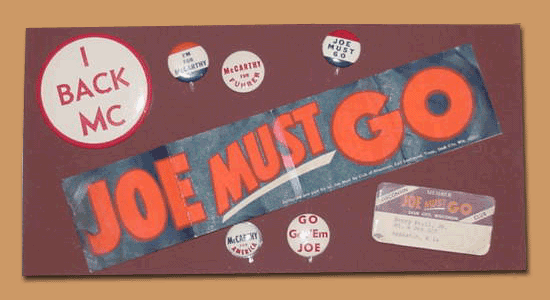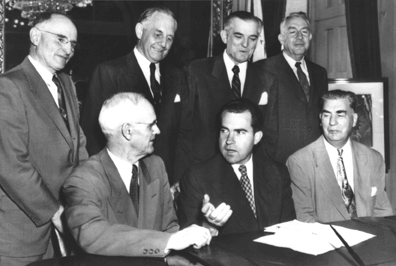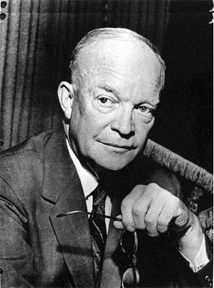
___________________________________________________________________________________________________________
___________________________________________________________________________________________________________
(Below) Eisenhower and McCarthy in 'An uncomfortable Situation', cartoon published 3 December 1953
___________________________________________________________________________________________________________
Seminars - R. Gerald Hughes rbh@aber.ac.uk
The Cold War: McCarthyism in an International Context - 11 October 2004 (Monday 9-11.00am - Library seminar room)
McCarthyism in American Life - 18 October 2004 (Monday 9-11.00am - Library seminar room)
HUAC Goes to Hollywood - 25 October 2004 (Monday 9-11.00am - Library seminar room)
The Eisenhower Years - 1 November 2004 (Monday 9-11.00am - Library seminar room)
(Above left to right) Nixon and Eisenhower campaign poster (1952); Dwight D. Eisenhower; Senator Joseph McCarthy in 1950
___________________________________________________________________________________________________________
The Cold War: McCarthyism in an International Context
(Above, l-r) 'Red Scare', 1919; Truman ('I am sick of babying the Soviets' 5 January 1946); Marshall
Between 1939 and 1945 the Gross National Product of the US rose from about $95 billion to $215 billion, proof that fighting World War II was the foundation of American economic strength immediately after 1945. Despite the end of the war and demobilisation the US maintained a concerted military presence in western Europe and parts of Asia, extending its influence against the perceived threat of Soviet and communist expansion through the Truman Doctrine, the Marshall Plan and the formation of NATO in 1949. The US rise to globalism was matched by the USSR's growth in economic might and military power. Rivalry between East and West quickly spiralled into a Cold War characterised by mutual suspicion and hostility. The US pursued a policy of containment, whereby Americans sought to counter outright Soviet aggression and undermine what was interpreted as communist subversion abroad and at home. Anxiety at the prospect of communist expansion abroad (which in 1949 was only heightened by the news that the Soviets had developed atomic weaponry and the communists had taken over in China) led to military intervention in the Korean War, a conflict which highlighted the difficulty of gaining an outright military "victory" over opposition forces. During this seminar we'll examine the development of the Cold War in its international context while also noting the growing sense that since the US was not prospering as well as it might after the success of World War II that it must be suffering from internal subversion, the undermining of US government by communist agents working within its framework.
Required Reading:
Ellen Schrecker, The Age of McCarthyism (selections)
John Diggins, The Proud Decades, chs. 1 and 2
Kennan's 'Long telegram' (excerpts)
The Truman Doctrine (documents)
Why did the United States come to regard the Soviet Union as such a threat after World War Two?
What were the main features - and significance - of the following: the 'Long telegram'; the Truman Doctrine; the Marshall Plan; NSC-68.
What do we understand by the term 'Containment'?
How did the Cold War provide such a rich environment for the rise of McCarthyism?
___________________________________________________________________________________________________________
McCarthyism in American Life
In this seminar we turn to look at the domestic impact of McCarthyism. Anticommunism in American life reflected not only a phase in the development of American foreign policy, but also a particular moment in American domestic politics, as the Republican party sought to claw its way back into power after being eclipsed for two decades by the Democrats under Roosevelt and Truman, and as conservatives sought to roll back some of the liberal advances of the New Deal years. We examine the domestic roots of McCarthyism and the various social and political struggles which fed it. We examine also the manner in which McCarthyite investigations operated: the "guilt by association," the demands for overt displays of loyalty, and the pressure to give names, noting the role played by organisations like the FBI and HUAC (The House Un-American Activities Committee). And we examine the impact of McCarthyism on institutions like the Democratic party, the labour movement, and the universities, as well as the American Left.

Anti- and Pro-McCarthy
political paraphernalia, 1952-1954
Required reading:
Ellen Schrecker, ed., The Age of McCarthyism
John Diggins, The Proud Decades, chs. 3 and 5
Stephen E. Ambrose, Eisenhower: Soldier and President, ch. 14
Censure of Senator Joseph McCarthy (1954)
Assess the facts with regard to the debates on 'Who lost China' after 1949? How did they interact with domestic American politics? Group One
Why was the State Department such a target for anti-communist hysteria? What was the domestic political significance of the Alger Hiss case? Group Two
What were the main tactics employed by McCarthy? How effective were they? Group Three
How did the Republican Party use McCarthyism? Group Four
What brought about the downfall of McCarthy? Group Five
 Vice-President
Richard Nixon (sitting centre) posing with members of the Watkins Committee in
charge of reviewing a censure resolution against McCarthy, August 5, 1954.
Seated left to right: Senator Arthur V. Watkins (R-Utah), Nixon, and Senator
Edwin C. Johnson (D-Colo). Standing left to right: Senators Francis Case (R-SD),
Frank Carlson (R-Kans), John C. Stennis (D-Miss), and Sam J. Ervin, Jr., (D-NC).
Vice-President
Richard Nixon (sitting centre) posing with members of the Watkins Committee in
charge of reviewing a censure resolution against McCarthy, August 5, 1954.
Seated left to right: Senator Arthur V. Watkins (R-Utah), Nixon, and Senator
Edwin C. Johnson (D-Colo). Standing left to right: Senators Francis Case (R-SD),
Frank Carlson (R-Kans), John C. Stennis (D-Miss), and Sam J. Ervin, Jr., (D-NC).
___________________________________________________________________________________________________________
HUAC Goes to Hollywood
HUAC in session, 1947 (chaired by J. Parnell Thomas (R-NJ)
The paranoia of Invasion of the Body Snatchers is difficult to locate: is this a film about the threat posed by an alien, un-American communist takeover, or is it a film about the takeover of the US by the right-wing forces of McCarthy, forces which are imposing a deadening, unreflective conformity on an unsuspecting civilian population? We will also consider the case of On the Waterfront seems to be a left-wing, liberal film, particularly when we remember that it started out as a collaboration with Arthur Miller and deals with the question of trade unions. But director Elia Kazan saw the film as a defence of HUAC activities; he willingly co-operated with the committee, whereas Miller did not. Yet both men had struggled for years to make the film, fighting a hostile Hollywood system which was deeply suspicious of films which dealt with contemporary political issues. More generally, there were elements within the Hollywood system that were hostile to McCarthy, but their protests were short-lived and ineffectual; resistance became a clandestine and piecemeal affair, frequently interrupted by betrayal.
Required reading/ viewing:
Invasion of the Body Snatchers (Dir. Don Siegel, 1955)
Dr. Strangelove (Dir. Stanley Kubrick, 1964)
Daniel Leab, 'How red was my valley: Hollywood, the Cold War film, and I married a Communist', Journal of Contemporary History, vol. 19 (1984), pp. 59-88
Tony Shaw, ‘Martyrs, Miracles and Martians: Religion and Cold War Cinematic Propaganda in the 1950s’, in Journal of Cold War Studies, vol. 4, no. 2 (Spring 2002), pp. 3-22
From the CNN Cold War site:
 |
|
 |
The Movie Club:
"Big Jim McLain" |
|
|
|
 |
The Red Scare Goes
Hollywood |
More reviews
Questions for groups
___________________________________________________________________________________________________________
The Eisenhower Years

How does one assess the ‘Ike Age’? Are the Eisenhower years to be seen solely as a period of middle-class consolidation, with the emergence of an American conservatism? Or were there signs of a more radical progress being made in American society? Was it, in Diggins’ term, a ‘Proud Decade’? Or are their features which redeem the decade from political inertia? What was the impact on American society and culture of the nation's new international obligations after World War II? Involvement in the Cold War induced a sense of public insecurity and frustration that found expression in the anti-communist hysteria of McCarthyism. But McCarthyism was also a wide-ranging attack on the political Left and on cultural diversity. To what degree did this struggle against communism define the limits of what was ideologically and culturally legitimate, of what constituted the boundaries of "100% Americanism"?
Required Reading:
Stephen E. Ambrose, Eisenhower: Soldier and President, chs. 10-22
John Diggins, The Proud Decades, chs. 4, 10, Conclusion
Eisenhower biographical sketch
(Above left) The Phil Silvers Show ('Sergeant Bilko'): the definitive comedy of the Eisenhower years
_______________________________________________________________________________________________
Essay questions
What agendas was the Republican Party pursuing with regard to their relationship with McCarthyism?
Were the Eisenhower years essentially a period of stagnation? What case could be made for stating that they were a 'Golden Age'?
_______________________________________________________________________________________________
RGH 2004
· American Studies UWA ·